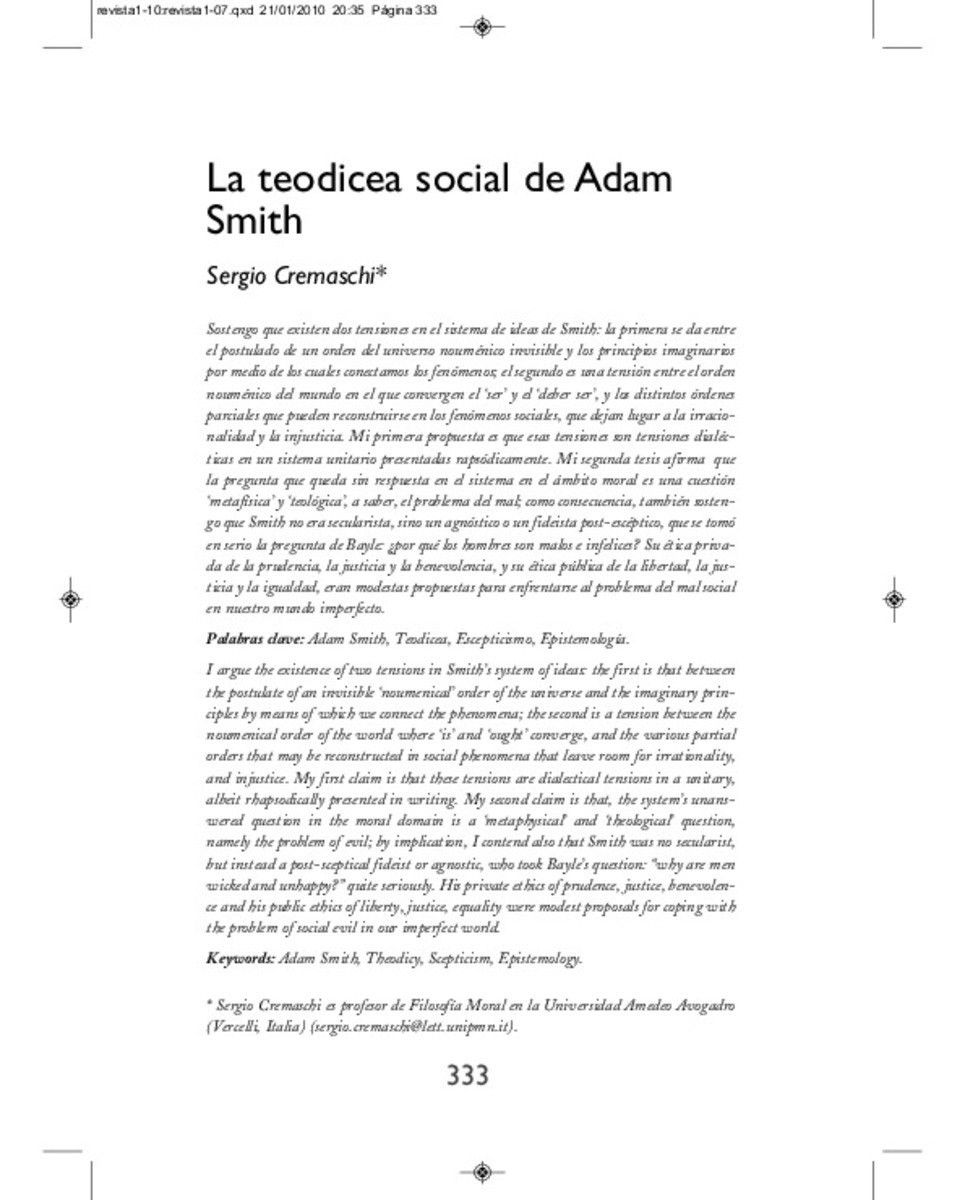Full metadata record
| DC Field | Value | Language |
|---|---|---|
| dc.creator | Cremaschi, S. (Sergio) | - |
| dc.date.accessioned | 2013-04-23T11:04:42Z | - |
| dc.date.available | 2013-04-23T11:04:42Z | - |
| dc.date.issued | 2010 | - |
| dc.identifier.citation | Cremaschi, Sergio. ""La teodicea social de Adam Smith"". Revista empresa y humanismo. 2010, VOL. 13, Nº. 1, PÁG.333-374. | es_ES |
| dc.identifier.issn | 1139-7608 | - |
| dc.identifier.uri | https://hdl.handle.net/10171/29102 | - |
| dc.description.abstract | Sostengo que existen dos tensiones en el sistema de ideas de Smith: la primera se da entre el postulado de un orden del universo nouménico invisible y los principios imaginarios por medio de los cuales conectamos los fenómenos; el segundo es una tensión entre el orden nouménico del mundo en el que convergen el 'ser' y el 'deber ser', y los distintos órdenes parciales que pueden reconstruirse en los fenómenos sociales, que dejan lugar a la irracionalidad y la injusticia. Mi primera propuesta es que esas tensiones son tensiones dialécticas en un sistema unitario presentadas rapsódicamente. Mi segunda tesis afirma que la pregunta que queda sin respuesta en el sistema en el ámbito moral es una cuestión 'metafísica' y 'teológica', a saber, el problema del mal; como consecuencia, también sostengo que Smith no era secularista, sino un agnóstico o un fideista post-escéptico, que se tomó en serio la pregunta de Bayle: ¿por qué los hombres son malos e infelices? Su ética privada de la prudencia, la justicia y la benevolencia, y su ética pública de la libertad, la justicia y la igualdad, eran modestas propuestas para enfrentarse al problema del mal social en nuestro mundo imperfecto.-----I argue the existence of two tensions in Smith's system of ideas: the first is that between the postulate of an invisible 'noumenical' order of the universe and the imaginary principles by means of which we connect the phenomena; the second is a tension between the noumenical order of the world where 'is' and 'ought' converge, and the various partial orders that may be reconstructed in social phenomena that leave room for irrationality, and injustice. My first claim is that these tensions are dialectical tensions in a unitary, albeit rhapsodically presented in writing. My second claim is that, the system’s unanswered question in the moral domain is a 'metaphysical' and 'theological' question, namely the problem of evil; by implication, I contend also that Smith was no secularist, but instead a post-sceptical fideist or agnostic, who took Bayle's question: "why are men wicked and unhappy?" quite seriously. His private ethics of prudence, justice, benevolence and his public ethics of liberty, justice, equality were modest proposals for coping with the problem of social evil in our imperfect world. | es_ES |
| dc.language.iso | spa | es_ES |
| dc.publisher | Servicio de Publicaciones de la Universidad de Navarra | es_ES |
| dc.rights | info:eu-repo/semantics/openAccess | es_ES |
| dc.subject | Adam Smith | es_ES |
| dc.subject | Teodicea | es_ES |
| dc.subject | Escepticismo | es_ES |
| dc.subject | Epistemología | es_ES |
| dc.subject | Theodicy | es_ES |
| dc.subject | Scepticism | es_ES |
| dc.subject | Epistemology | es_ES |
| dc.title | La teodicea social de Adam Smith | es_ES |
| dc.type | info:eu-repo/semantics/article | es_ES |
| dc.type.driver | info:eu-repo/semantics/article | es_ES |
Files in This Item:
Statistics and impact
Items in Dadun are protected by copyright, with all rights reserved, unless otherwise indicated.






